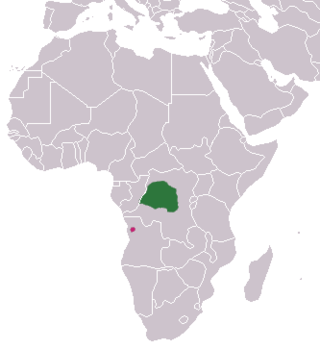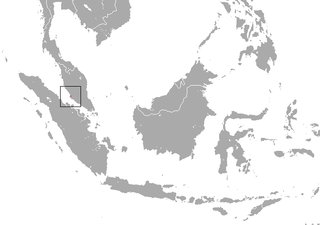
Acantholimon is a genus of small flowering plants within the plumbago or leadwort family, Plumbaginaceae. They are distributed from southeastern Europe to central Asia and also in South America, but also cultivated elsewhere in rock gardens.

Red-cheeked squirrels are species of squirrels in the genus Dremomys in the subfamily Callosciurinae. The six species which are all found only in Asia are listed as "Least Concern" by the IUCN.

The white-tipped tufted-tailed rat is a rodent endemic to Madagascar. It is known from only two specimens, one collected from Ampitambe forest in 1895 or 1896 and the second in 2000. It is listed by the International Union for Conservation of Nature (IUCN) as an endangered species due to habitat loss.

The Seram bandicoot, also known as the Seram Island long-nosed bandicoot, is a member of the order Peramelemorphia that is endemic to the island of Seram in Indonesia. It is the only species in the genus Rhynchomeles.

The hooktooth dogfish, Aculeola nigra, is a small, little-known dogfish, the only member of the genus Aculeola.

Nepenthes campanulata, the bell-shaped pitcher-plant, is a tropical pitcher plant native to Borneo. It has also been reported from Palawan, the Philippines, though further field work is needed to confirm this identification.

The Angolan kusimanse, also known as Ansorge's kusimanse, is a species of small mongoose. There are two recognized subspecies: C. a. ansorgei, found in Angola; and C. a. nigricolor, found in DR Congo, which do not have overlapping ranges. It prefers rainforest type habitat, and avoids regions inhabited by humans. It grows to 12–18 inches in length, with a 6–10 inch long tail, and weighs 1–3 lb. Little is known about this species of kusimanse, and there are no estimates of its wild population numbers or status. Until 1984, the species was only known from two specimens from Baringa but are now thought to be quite common in some regions. Threats are probably habitat loss and bushmeat hunting. However, this species is protected by Salonga National Park.

Pousargues's mongoose, also known as the African tropical savannah mongoose, is a mongoose native to Central Africa. It is listed as data deficient on the IUCN Red List as little is known about its distribution and ecology. It is the only species in the genus Dologale.

The northern pipistrelle, also known as Koopman's or the mangrove pipistrelle, is a species of vesper bat found only in Australia. It is one of Australia's smallest bat species. On average, it weighs 3 g (0.11 oz).
The eastern broad-nosed bat or Orion broad-nosed bat is a species of vespertilionid bat. It is found only in Australia, east of the Great Dividing Range, from about Rockhampton to Melbourne, with a small isolated population on the Atherton Tablelands.

The long-nosed Luzon forest mouse, also known as the Pinatubo volcano mouse, is a species of rodent in the family Muridae.

The Vanuatu megapode or Vanuatu scrubfowl is a species of bird in the family Megapodiidae. It was formerly known as the New Hebrides scrubfowl. It is found only in Vanuatu. Its natural habitat is subtropical or tropical moist lowland forest. The species is threatened by habitat loss and egg collecting.

Kihaule's mouse shrew is a species of mammal in the family Soricidae endemic to Tanzania where it is known only from the Udzungwa Mountains, at the western end of the Eastern Arc Mountains. Its natural habitats are subtropical or tropical moist montane forests and plantations. It is threatened by habitat destruction and the International Union for Conservation of Nature has assessed its conservation status as being "endangered". It was named after Philip M. Kihaule, a medical-entomological technician, who considerably contributed to the documenting of the small mammals of Tanzania and collected the type specimen of this shrew.

The Malayan roundleaf bat is a horseshoe bat found only in Malaysia. It is listed as a data deficient species.
The small Samoan flying fox is a species of fruit-eating megabat whose type specimen was originally collected in Samoa in 1856, but was not identified as a new species until 2009. Its wingspan was at least two feet, and it weighed around 8 oz. As the type specimen is dead, and no other examples of the species are known, it is believed to be extinct.
The large Samoan flying fox is a species of fruit-eating megabat whose type specimen was originally collected in Samoa in 1856, but was not identified as a new species until 2009. The only known specimen was collected by an American expedition to Samoa in 1838–1842. It was rediscovered by Smithsonian mammalogist Kristofer Helgen preserved in alcohol. It was the largest known bat from Polynesia. As the type specimen is dead, and no other examples of the species are known, it is believed to be extinct.
The spiny-flanked chameleon, also known as the spiny-sided chameleon, is a species of chameleon endemic to the United Republic of Tanzania, East Africa. It was first described in 1932 by Arthur Loveridge.
Acantholimon vedicum, the Vedian prickly thrift, is a species of leadwort that is endemic to central Armenia, and is only found in the Yerevan floristic region, on the limestone massif Erakh between elevations of 900–1,000 m, close to the city of Vedi. It is only known from its type specimens, and little is known of this species. It is threatened by nomadic livestock farming, which can lead to habitat loss and degradation.
Astragalus oltensis, the Oltuan astracantha, is a species of milkvetch that is endemic to Kars Province in Turkey. It is known only from its type specimen, and has not been collected again since. It was found on stony slopes at about 1,100 m elevation. It is threatened by overgrazing and erosion.
Nepenthes tboli is a tropical pitcher plant native to the Philippines. The type specimen was collected in 1993 around Lake Parker, T'Boli, South Cotabato, Mindanao, at 1,463 m (4,800 ft) above sea level.













